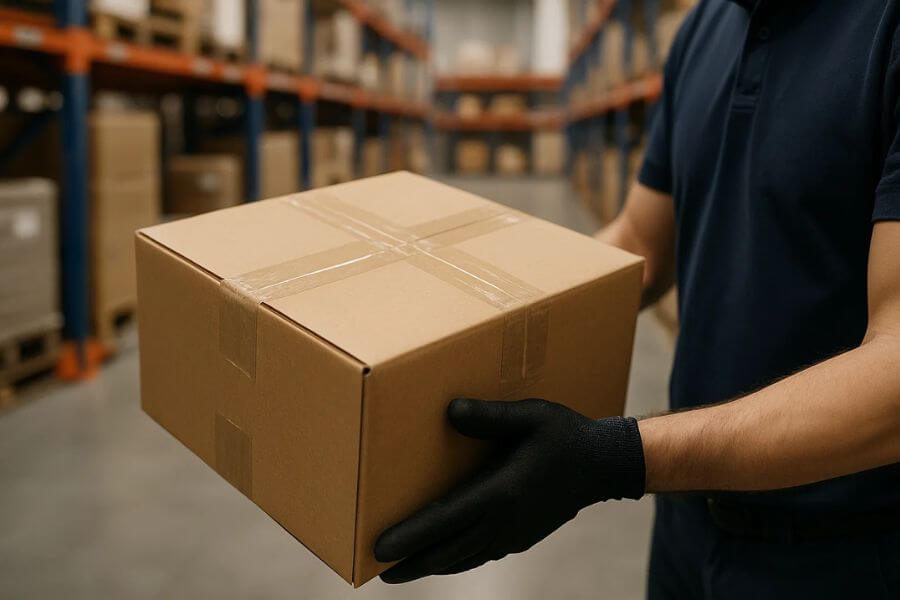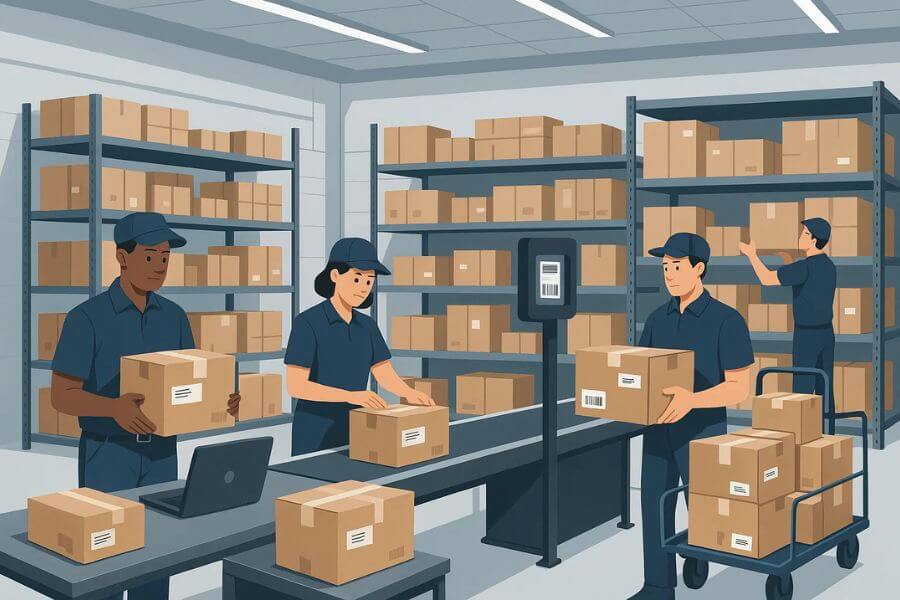Key takeaways
- EOQ is a strategic tool for efficient inventory management, helping businesses determine the optimal order quantity to minimize total inventory costs.
- EOQ is calculated using the formula EOQ = √(2DS)/H, where D represents demand rate, S represents ordering cost per order, and H represents holding cost per unit per year.
- EOQ is crucial for businesses to balance inventory levels, minimize costs, and enhance operational efficiency in today's competitive marketplace.
- EOQ allows businesses to make informed decisions about inventory management, leading to cost savings, improved customer satisfaction, and enhanced resource allocation.
- EOQ can be applied across various industries, including retail, manufacturing, ecommerce, and healthcare, to optimize inventory levels.
What is Economic Order Quantity?
In a world of business, keeping the right amount of inventory on hand is crucial. It’s a balancing act: you want enough to meet demand without tying up too much capital in excess stock. This is where Economic Order Quantity (EOQ) comes in handy. EOQ is like a magic number for inventory management. It helps businesses figure out the perfect amount of inventory to order or produce in one go. The goal? Minimize inventory costs while making sure you always have enough on hand to keep customers happy.
How to Calculate EOQ? The Formula
Don’t worry, you don’t need to be a math whiz to use EOQ. It’s all about plugging numbers into a simple formula:
EOQ = √2DS/H
Where:
- Demand Rate (D) – This is how fast your inventory flies off the shelves. Knowing your demand rate helps you plan how much inventory to keep on hand.
- Ordering Cost (S) – Every time you place an order, there are costs involved – paperwork, shipping fees, and maybe even supplier charges. EOQ helps factor these costs into your decision-making.
- Holding Cost (H) – Storing inventory isn’t free. There are costs like rent for warehouse space, insurance, and the opportunity cost of having money tied up in inventory instead of using it elsewhere. EOQ considers these costs, too.
What are the Importance of EOQ in eCommerce?
Economic Order Quantity (EOQ) steps in as a valuable ally for e-commerce businesses, helping them find the sweet spot between stocking enough products and keeping costs in check. Let’s take a look at why EOQ matters in e-commerce and how it empowers businesses to run smoother operations, keep customers happy, and stand out in the competitive online marketplace.
- Smart Spending – In the fast-paced world of e-commerce, every penny counts. EOQ helps businesses make savvy decisions by finding the perfect balance between storing inventory and the costs of ordering more. It’s all about getting the most bang for your buck.
- Happy Customers – Picture this: your favorite online store always has what you need, exactly when you need it. That’s the power of EOQ. By keeping just the right amount of stock, businesses can avoid frustrating stockouts and ensure customers get their orders on time, every time.
- Smooth Sailing – EOQ takes the hassle out of inventory management. With clear guidelines on when and how much to reorder, businesses can automate the process and focus on what they do best – providing top-notch products and services.
- Getting Creative – By optimizing inventory levels, EOQ frees up cash that businesses can invest in growth opportunities. Whether it’s launching a new marketing campaign or expanding product lines, EOQ gives businesses the flexibility to explore new avenues.
- Building Bonds – EOQ isn’t just about numbers – it’s about relationships too. By working closely with suppliers and establishing consistent ordering patterns, businesses can foster stronger ties and unlock perks like better pricing and faster delivery times.
- Staying Ahead – In a crowded online marketplace, standing out is essential. EOQ gives businesses a competitive edge by helping them offer competitive prices, faster shipping, and a smoother shopping experience – all factors that keep customers coming back for more.
4 Things that EOQ Tells You
Economic Order Quantity (EOQ) is like a magic formula that helps businesses figure out the perfect amount of inventory to order. Let’s break down what EOQ tells us in simpler terms:
- Ordering Just Enough – EOQ helps businesses avoid ordering too much or too little inventory. Ordering too much means wasting money on storage costs for excess inventory, while ordering too little can lead to extra expenses for frequent orders. EOQ finds that sweet spot where businesses order just the right amount to save money and keep operations running smoothly.
- Saving Costs – EOQ isn’t just about ordering the right amount; it’s also about saving money. By balancing holding costs like storage and capital tied up in inventory, and order costs like shipping and handling, EOQ helps businesses minimize their total inventory expenses.
- Running Efficiently – EOQ gives businesses a roadmap for managing their inventory effectively. With EOQ, they know exactly when to reorder and how much to order, avoiding situations where they run out of stock or end up with piles of unsold goods. This efficiency means happier customers and smoother operations.
- Smart Resource Use – EOQ isn’t just about inventory – it’s also about making the most of resources. By ordering the optimal quantity suggested by EOQ, businesses free up cash that can be invested in other areas, like marketing or expanding their product range.
3 Examples of How to Use EOQ
1. Online Retailer
Imagine an online retailer selling smartphones. They have historical data showing that they sell an average of 500 smartphones per month (demand rate, D). Each time they place an order with the supplier, they incur ordering costs of $100 (ordering cost per order, S). Additionally, the holding cost per smartphone per year is $5 (holding cost per unit per year, H).
To calculate EOQ, the retailer would use the EOQ formula: EOQ = √2DS/H
Plugging int he values, we get: EOQ = √(2x500x100)/5
Solving this equation, the EOQ for the retailer would be 632 smartphones. This means that ordering approximately 632 smartphones at a time would minimize their total inventory costs.
2. Manufacturing Company
A manufacturing company produces a particular component used in electronic devices. They estimate their annual demand for this component to be 10,000 units (D). The ordering cost per order is $200 (S), and the holding cost per unit per year is $10 (H).
Using the EOQ formula: EOQ = √(2DS)/H
Substituting the values, we get: EOQ = √(2×10,000×200)/10
The calculated EOQ for the manufacturing company is 894 units. Therefore, ordering approximately 894 units at a time would help minimize their total inventory costs.
3. Wholesale Distributor
A wholesale distributor deals with a variety of products, including office supplies. They observe that their annual demand for a particular type of printer ink cartridge is 5,000 units (D). The ordering cost per order is $50 (S), and the holding cost per unit per year is $8 (H).
Applying the EOQ formula: EOQ = √(2DS)/H
Plugging in the values, we get: EOQ = √(2×5,000×50)/8
After calculation, the EOQ for the wholesale distributor is approximately 158 cartridges. Thus, ordering around 158 cartridges at a time would help optimize their inventory management and minimize costs.
Economic Order Quantity (EOQ) FAQs
What are the benefits of using EOQ?
Think of EOQ as your money-saving buddy! It helps businesses cut costs, manage inventory better, keep customers happy, and use resources wisely. With EOQ, businesses can avoid running out of stock or having too much inventory sitting around, which means happier customers and more money in the bank.
Is EOQ applicable to all types of businesses?
EOQ isn’t picky – it works for everyone! Whether you’re selling smartphones, building houses, or running a library, EOQ can help you manage your inventory smarter. It’s like a universal tool that businesses of all shapes and sizes can use to save money and run smoother operations.
What assumptions are made in EOQ calculations?
EOQ isn’t perfect, but it’s pretty close! It assumes things like steady demand, consistent ordering costs, and holding costs that don’t change over time. While these assumptions might not always match reality perfectly, EOQ still gives businesses a good starting point for managing their inventory.
How frequently should EOQ be recalculated?
EOQ isn’t a set-it-and-forget-it kind of thing – it needs a little TLC now and then! Businesses should update their EOQ calculations regularly to keep up with changes in demand, costs, and other factors that might affect inventory management.
Are there any limitations to EOQ?
EOQ isn’t a magic wand – it has its limits! For example, it assumes that everything stays the same, which isn’t always the case in the real world. Businesses should be aware of EOQ’s limitations and use it as part of a large strategy for managing inventory.
How can businesses implement EOQ in practice?
Implementing EOQ is easier than you might think! Businesses just need to gather some data, plug it into the EOQ formula, and use the results to make smarter decisions about inventory. It’s like having a secret weapon for saving money and running a tighter ship!
Does EOQ account for seasonal fluctuations find demand?
EOQ might not be great at predicting the weather, but it can handle seasonal changes in demand! Businesses can tweak their EOQ calculations to account for busy seasons or slow times, making sure they always have enough stock when customers come knocking.
Conclusion
In today’s fast-paced business world, managing inventory efficiently is crucial. That’s where Economic Order Quantity (EOQ) comes in! EOQ isn’t just a fancy term – it’s a game-changer for businesses looking to stay ahead of the curve. By embracing EOQ, both retail and online businesses can tackle inventory challenges head-on, making smart decisions that drive competitiveness and fuel growth. Think of EOQ as your secret weapon, helping you balance inventory levels, cut costs, and wow customers with top-notch service.





